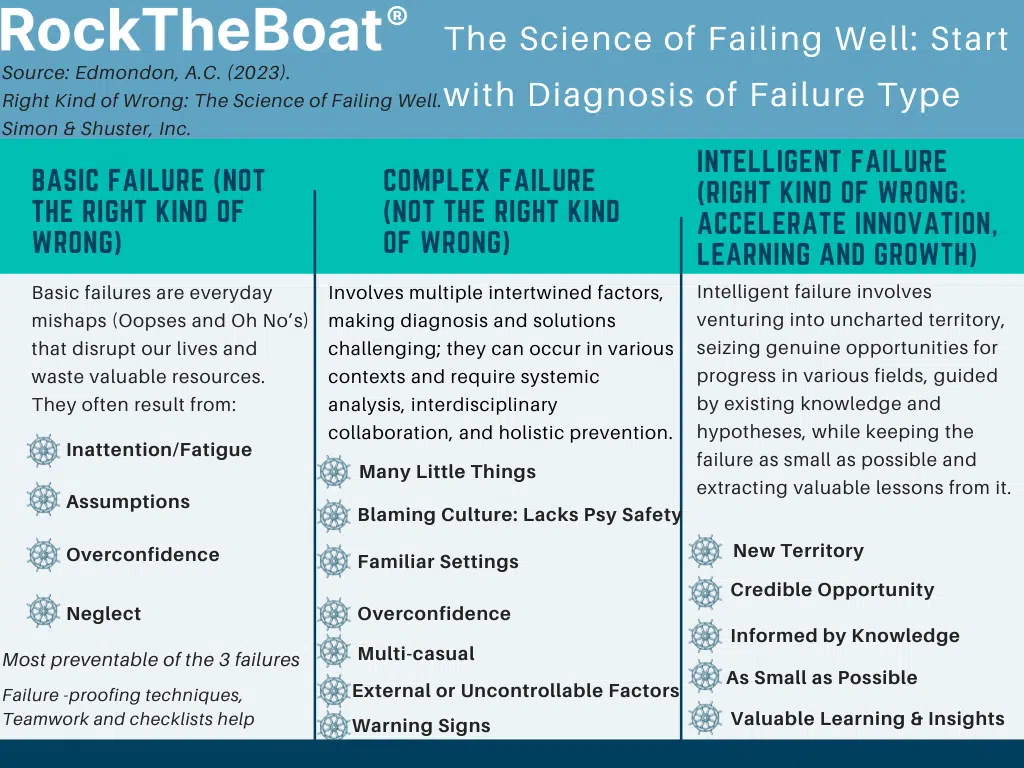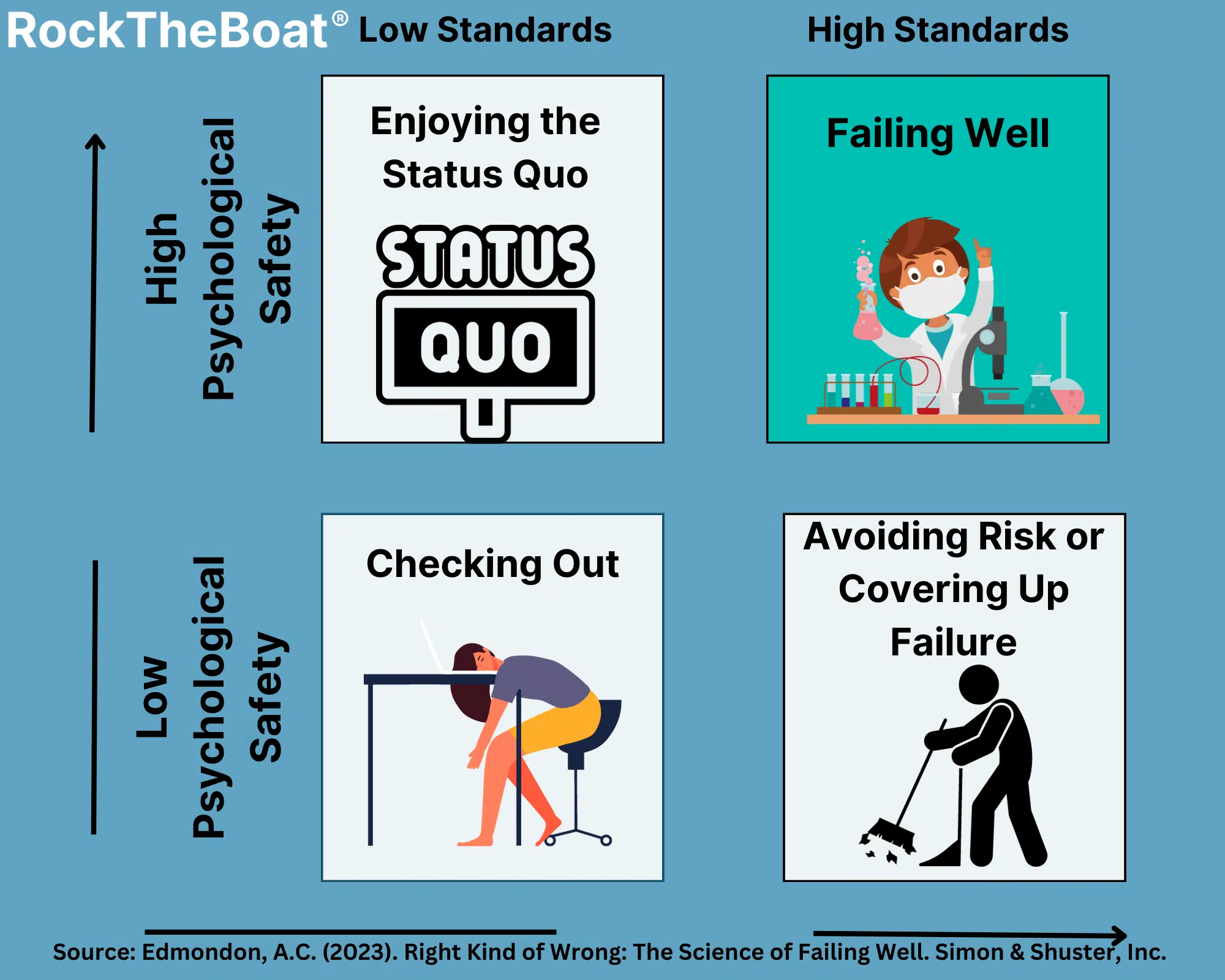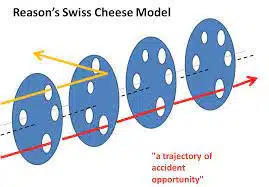Amy Edmondson’s ‘The Right Kind of Wrong’ Insights
Success is often celebrated and rewarded in innovation, while failure is aversive, painful, shameful, feared, and confusing. However, what if we told you that failure, when done right, can be a stepping stone to greatness? Amy Edmondson, a Novartis Professor of Leadership and Management at Harvard Business School, delves deep into this intriguing concept in her new book, which made it onto the Financial Times shortlist for business book of the year “The Right Kind of Wrong: The Science of Failing Well.” #rightkindofwrong In this blog post, we’ll explore the key insights from Edmondson’s thought-provoking book and how embracing failure can lead to remarkable achievements.
Right Kind of Wrong Insights:
The Science of Failing Well: Start with Diagnosis of Failure Type
The Science of Failing Well Encompasses Three Key Principles:
- Minimizing Basic Failures: Basic failures result from known and avoidable mistakes or errors in routine processes. Organizations and individuals can significantly minimize these failures by identifying these basic failures and implementing effective strategies. This approach ensures that the foundation of any endeavor is solid and reliable.
- Anticipating and Mitigating Complex Failures: Complex failures are typically characterized by the interplay of multiple factors, making them challenging to predict and address.
- Promoting Intelligent Failures: This principle encourages promoting, soliciting, and celebrating intelligent failures. Intelligent failures occur when individuals or organizations take calculated risks to test new ideas or approaches.
The Presence or Absence of Psychological Safety Matters
Fostering Psychological Safety and Belonging on Teams
- Promote a learning culture and learner’s mindset.
- Encourage a speak-up culture to raise concerns, flag errors, and catch and correct mistakes.
- Embrace a praiseworthy and blameless interpersonal climate.
- Facilitate complex failure prevention efforts.
- Awareness of complex -failure propensity.
- Vigilant employees spot problems early by paying close attention to minor signs, helping prevent more significant issues.
- Pay attention to ambiguous threats and address them accordingly.
Absence of Psychological Safety and Belonging on Teams:
- Do you have a suppressive cultural attitude that disempowers employees from speaking up about problems or criticism of corporate policy?
- Do you have a blameworthy culture?
- Fear losing your job if you speak up?
- Do you ignore warning signs?
- Do you prioritize profits, shareholder value, or production over safety?
- Do you downplay failure?
Fostering a Culture of High Standards and Safe Failure Discussions
Interpersonal Climate
A workplace can nurture psychological safety while demanding exceptional performance and meeting deadlines.
Unlocking Success: Learning from Complex Failures for a Safer Future
Lessons from the Swiss Cheese Model: Understanding Failures and Improving Safety
The Swiss Cheese Model
- Explains accidents, like medical errors or plane crashes.
- Imagine safety barriers as slices of Swiss cheese stacked together.
- Each slice has small problems or mistakes (holes).
- Normally, if one slice has a hole, the next can stop the problem.
- Accidents happen when the holes in the slices align, like holes in real cheese.
- It shows that accidents result from a series of errors and problems aligning, not just one mistake.
- This model highlights the need for multiple safety barriers to prevent accidents and improve safety.
Building Reliability: How High-Reliability Organizations Learn from Failure
Weick, K. E., Sutcliffe, K. M., & Obstfeld, D. (1999). Organizing for High Reliability: Processes of Collective Mindfulness. In Research in Organizational Behavior, Volume 21, 81-123. JAI Press.
Proactive Strategies for Preventing Complex Failures
Optimizing Recovery Opportunities: Leveraging the Recovery Window
Step 1: Consider when recovery is possible before something goes wrong. This time frame starts when someone notices the slightest hint that a problem might arise. It ends when the problem happens. These windows for recovery can vary from just a few minutes to several months.
Step 2: Once you realize that something might be going wrong, it’s crucial to seize the opportunity. First, try to gather more information to understand the situation better. Then, take action to fix the issue or prevent it from getting worse.
Embracing False Alarms: Maximizing Early Warning Systems
Step One: Begin by Adjusting Your Perspective on False Alarms
Step Two: Foster a mindset that views it as a beneficial exercise and a valuable chance for learning and team building.
Step Three: Consider implementing a rapid response team (RRT) depending on your industry context. RRT is useful in noticing and naming warning signals and addressing them collaboratively. RRT is a tool for amplifying ambiguous threats.
Think Beyond The Thing
Step 1: Catch: Something has gone wrong, and respond systematically.
Step 2: Correct: Ensure everyone has a safe space to voice, share, challenge, be heard, and collaborate about decisions or solutions moving forward.
Embracing the Possibility of Failure to Reduce the Occurrence of Failure
Step 1: Framing: Explicitly emphasizing the complexity or novelty of a situation helps put you in the right state of mind
Step 2: Amplifying: Make sure a signal can be heard, as it is human nature to ignore or downplay things.
Step 3: Practicing: rehearsal, dry runs, drills, and practice sessions.
Failing Well: Become An Elite Failure Practitioner
Willingness to Learn and Self-Reflect
- Willingness to discover and acknowledge shortcomings
- Stance of Humility
- Welcome and Nurture Curiosity
- Embrace Uncertainty: How do I know I am right?
- Overcome Certainty: I’m right
Resilience and Persistence
- Resilience, Determination, and Perseverance: Demonstrating persistence and not giving up easily
Mindset and Learning Orientation
- Growth/Learners’ Mindset over Fixed/Knowing Mindset
- Feedback-Seeking: Actively seeking feedback and constructive criticism.
- Avoid blaming someone or something
- Frame and Reframe (Pause and challenge automatic assumptions/associations)
- Amplify
- Practice
Emotional Intelligence and Self-Improvement
- Emotional Intelligence: Understanding and managing your emotions in the face of failure
- Overcome confirmation bias and the sunk-cost fallacy that protects self-esteem
- Overcome defensiveness, a non-learning frame of self-protection
Source
Edmondson, A.C. (2023). Right Kind of Wrong: The Science of Failing Well. Simon & Shuster, Inc.
Weick, K. E., Sutcliffe, K. M., & Obstfeld, D. (1999). Organizing for High Reliability: Processes of Collective Mindfulness. In Research in Organizational Behavior, Volume 21, 81-123. JAI Press.
Recommended Reading:
Edmondson, A.C. (2023). Right Kind of Wrong: The Science of Failing Well. Simon & Shuster, Inc.
The Intelligent Failure that Led to the Discovery of Psychological Safety
Organizing for High Reliability- Processes of Collective Mindfulness
Watch:
The Science Of Failing Well, According To Author Amy Edmondson
Meet Jodie, your Culture & Transformation Captain. With over twenty years helping people change, facilitating team discussions, building cultures, designing, implementing and teaching classes, your organization is in good hands.






